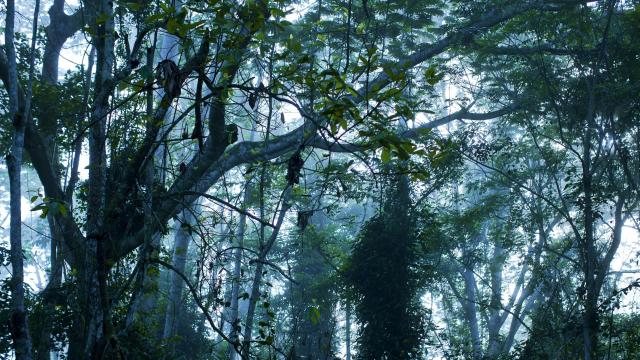The Congo Basin is the second-largest rainforest on Earth, and like most tropical forests, it’s getting chewed up by humans. That’s a problem for the climate, and not just because trees are a natural sponge helping to mop up humanity’s ever-rising carbon emissions.
New research suggests that as trees are replaced with fields for agriculture, carbon that’s been locked up in the Congo’s soils for hundreds to thousands of years is starting to seep out.
Soils hold a tremendous amount of carbon — more than the atmosphere and living vegetation combined. About a third of that carbon resides in soils in the tropics, areas that are undergoing profound changes due to population growth, industry and agriculture.
As the trees are lost, scientists are wondering what will become of all the partly decomposed organic stuff locked away beneath them.
This question is especially relevant in the Congo Basin, where the rainforest is being steamrolled for agriculture and charcoal production so quickly that researchers have predicted all of the oldest stands of trees could be gone by the end of the century.
Now, a team led by researchers at Florida State University has taken a first stab at determining what the rapidly-unfolding changes in the region could mean for the 20 billion tonnes of carbon stored in the Congo’s forest soils.
To do so, the researchers took samples of river water from 19 sites in the Kivu region of the eastern Democratic Republic of Congo, representing a gradient from pristine forest to completely deforested. (An estimated 2400 square km of forest were lost in the region from 2000 to 2010.)
They looked at the radiocarbon age and chemical makeup of dissolved carbon, which leaches into the rivers from the nearby soils, providing a good indicator of what’s being lost from the system.
The findings were stark. While pristine forests were leaking young, modern carbon that plants had recently pulled out of the air via photosynthesis, the carbon escaping the completely deforested sites was about 1500 years old.
This age indicated to the researchers that they were looking at carbon from deeper parts of the soil — stuff that was once stable but, as the trees are cleared and fields are plowed, is being surfaced and lost.
“Most of our deforested catchments had lost their tree cover more than two decades before the study, so post-deforestation erosion is a major factor,” study author Travis Drake told us in an email. “The seasonal tilling of croplands followed by heavy rains likely erodes the surface soils, exposing the older [carbon] we measured in the streams.”
Further analysis showed that the stuff leaking out of degraded ecosystems was also more “labile”, a soil science term that basically means “delicious microbe fuel”. This is the carbon that’s most susceptible to being digested by microorganisms and, ultimately, released to the air as carbon dioxide.
To that point, in the deforested streams, levels of dissolved carbon dioxide were about 900 parts per million higher than they were in forested streams. These streams were also much warmer on average (likely due to the loss of shade cover afforded by trees), further priming them for microbial decomposition.
It’s too early to say how much old soil carbon has already been lost, or could potentially be lost, as land is cleared — the new study “really just identified that this process is taking place,” as Drake put it. The researchers are currently working to better quantify carbon losses from agricultural soils, in addition to extending their work to the Congo’s central lowland forests.
The authors do have a few suggestions for things that can be done to keep the problem from getting worse, though. Stopping all deforestation may be the best option from a climate perspective, but with the population set to continue growing and folks relying on agriculture for, well, their food, that seems like a bit of a pipe dream.
Finding other uses for the forest so that the losses can be slowed, and educating farmers about techniques they can use to protect their soils, would also be immensely helpful.
“Generally, classic sustainable agricultural practices would probably go a long way, especially the implementation of terraces to prevent erosion,” Drake said.
